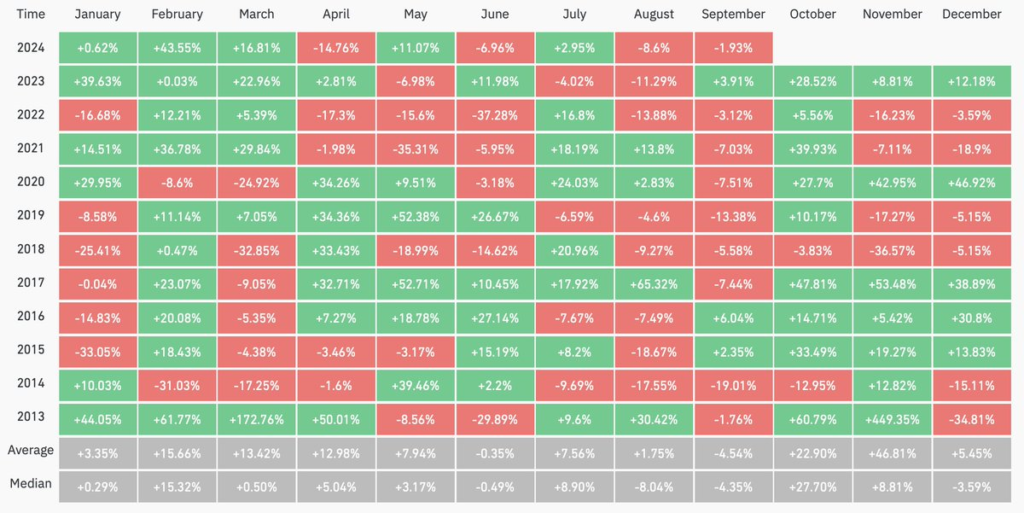

Table of Contents
Introduction: Volatile September Starts for Bitcoin
From a one-month high of $65,000 on August 25th to as low as $57,100 on Monday, Bitcoin’s price has lately dropped significantly. Investors, particularly as the U.S. Federal Reserve (Fed) gets ready to make its next interest rate decision, are growing increasingly worried about the continuous drop in the value of Bitcoin. The long-term trajectory of Bitcoin in the larger cryptocurrency market as well as its short-term volatility could be greatly affected by this important choice.
September’s Affect on the Forecast of Bitcoin Price
Historically, September is erratic for Bitcoin; this year seems to be different. A recent Bitfinex Alpha analysis claims that the future interest rate decisions of the Fed might have a major impact on the market behavior of Bitcoin. Driven mostly by expectation of dovish Federal Reserve comments, Bitcoin has surged over 32% early in August. Although this conjecture has inspired traders’ hope, the possible results of the Fed’s choice remain a two-edged blade.

Possible Results of Fed Rate Reduction
Currently expecting the Fed to cut rates by 25 basis points, the market could indicate the start of an easing cycle. This choice would probably boost market liquidity, which might cause long-term price rise for Bitcoin. Conversely, a more aggressive 50 basis point cut could immediately cause the price of Bitcoin to rise, but it could also set off a later correction as recession worries reappear.
Forecasts from Bitfinex indicate that a rate cut could cause a 15–20% drop in the price of Bitcoin, so maybe bottoming out between $40,000 and $50,000. Based on past trends, which show that average corrections during bull markets decrease and peak returns in each cycle drop by roughly 60 to 70%, this forecast is made.
Bitcoin’s September Performance Historically
Historically, September has not been friendly for Bitcoin; its average return is -4.78% and its typical peak-to–trough drop is about 24.6%. These trends imply that the price of Bitcoin might be under great pressure in the next weeks, particularly if more general economic conditions keep declining. Furthermore, the growing link between Bitcoin and conventional risk assets like the S&P 500 suggests that its price swings will closely reflect more general macroeconomic patterns.
Globally Economic Dynamics and Their Impact on Bitcoin
The paper also emphasizes the more general worldwide economic dynamics that might influence the price of Bitcoin. Reacting to slowing development and economic uncertainty, central banks all around—including the People’s Bank of China (PBOC) and the European Central Bank (ECB)—are acting cautiously. For example, the ECB is debating stopping rate increases while the PBOC is using focused liquidity initiatives to help in recovery.
Driven by strong household consumption and pay rise above inflation, the American economy shows indications of continuous disinflation. The PCE index, the Fed’s favored inflation gauge, climbed 2.5% in July, so supporting the story of price stability. Further easing worries about an economic downturn are recent upward changes to Gross Domestic Product (GDP) growth for the second quarter, now at a 3% annual rate.
Still, problems abound, especially in the housing market where declining mortgage rates have resulted in record low pending home sales. These conflicting signals increase the uncertainty about the Fed’s forthcoming decision and possible influence on Bitcoin.
Political Involvement and Control of Bitcoins
The junction of politics and bitcoin control is starting to be rather important. Political involvement with bitcoin issues is becoming more common in the United States. Especially, presidential contender Donald Trump has revealed a plan meant to establish the United States as a world leader in cryptocurrencies. Trump’s participation with the World Liberty Financial distributed finance project highlights the growing political curiosity in the bitcoin industry.
Apart from political changes, the 24X National Exchange has suggested a 24/7 trading platform for ETFs based on cryptocurrencies in order to seek legislative clearance to improve market accessibility. This action might help to include cryptocurrencies more into the mainstream financial system, so raising their acceptance and impact.
Market Reactions: The Tuesday Crypto Melt-through
The market for cryptocurrencies dropped once more on Tuesday, following weeks of erratic behavior. Bitcoin was down 1.5% to $57,800 ninety minutes after U.S. stock markets opened following the Labor Day holiday; Ether (ETH) dropped 3% to $2,442, marking its lowest level since early February.
With a few members showing meager gains, the broad market gauge—the CoinDesk 20 Index—was down only 1%. But given a significant drop in U.S. stocks, the general market attitude stayed negative. Further erasing investor confidence, the Nasdaq dropped 2.4% and the S&P 500 dropped 1.5%.
American Economic Data: Consequences
This market response matched the publication of the August ISM Manufacturing PMI report, which indicated ongoing manufacturing sector contraction. With new orders down and prices paid rising, the report came in at 47.2, below expectations and suggested a stagflationary environment.
Responding to these poor economic data, traders have raised the likelihood of a 50 basis point rate cut by the Fed in September to 39%, from 30% the day before. Still, the general expectation stays a 25 basis point reduction at 61%.
Scheduled for publication on Friday, the August employment report is the major event driving U.S. macroeconomic news this week. From the soft print of 114,000 in July, economists are projecting a comeback in job gains to 160,000. From 4.3%, the unemployment rate should somewhat drop to 4.2%. With major ramifications for Bitcoin and other cryptocurrencies, the result of this report might be a decisive influence on the Fed’s last interest rate decision.
Conclusion: Navigating Bitcoin’s Uncertain Future
The market stays on brink as Bitcoin keeps under downward pressure, waiting for the Fed’s forthcoming interest rate decision. Depending on the degree of the rate reduction, the possible results of this choice could cause a notable price correction or a brief surge. Furthermore very important in determining Bitcoin’s direction in the next months are more general economic trends and worldwide central bank policies.
The actions of the Fed and the publication of important economic data should be closely watched by investors since these events will probably affect market mood and impact the value of Bitcoin. The market for cryptocurrencies is still erratic in the meantime, and both buyers and sellers are preparing for possible upheaval.
All things considered, the future of Bitcoin is closely entwined with the state of the economy; hence, the forthcoming Fed action might be a turning point. Whether Bitcoin will recover or keep falling will rely on a complicated interaction of macroeconomic elements, political events, and market mood. As usual, navigating the erratic world of cryptocurrency investing will depend mostly on remaining informed and ready for several outcomes.
Disclaimer
This is just meant to be information; it is not financial or investment advise. Unexpected changes in market conditions mean that before making any financial decisions, one must carefully study and consult a professional.
For further insights, visit our cryptocurrency website
Explore more about [Bitcoin’s price movements and market trends]






Be the first to comment